Culo Cards
Kerry Doran
March 11, 2019
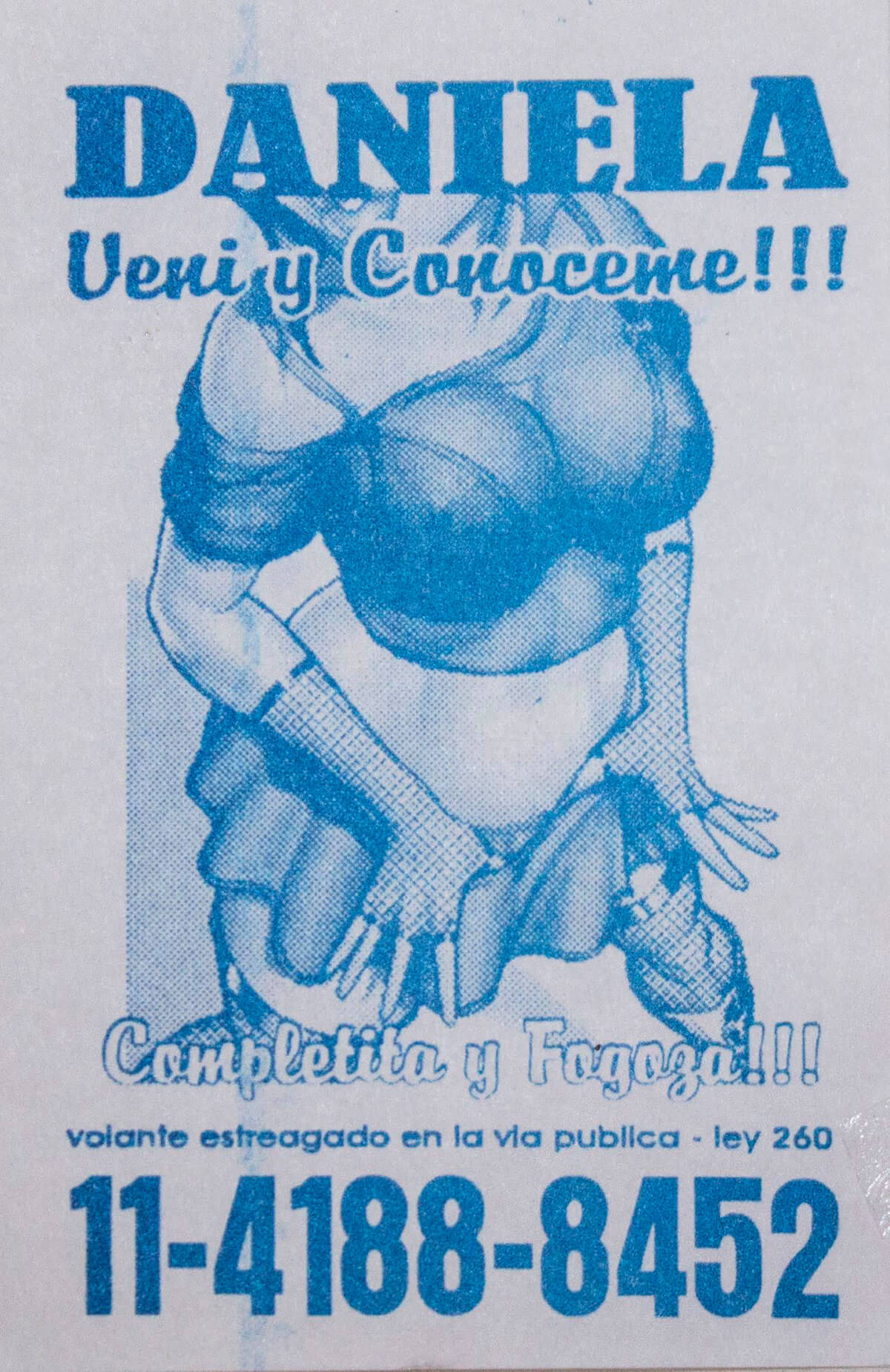
Veni y Conoceme!!! Come and meet me, she says. You don’t have her number saved in your phone. Instead, you keep it on a small piece of paper in your wallet. You could call.
Daniela is a dirty little secret, but she’s everything you want. You remember her luscious cherry ass, scantily covered by a little schoolgirl skirt, and her nipples, begging to be touched through her bra, barely veiled in a mesh top. She exudes sex, but she’s sweet, too. Completita y Fogoza!!! She will do anything you want.
Daniela is too good to be true. So are Lola, Carla, Vanesa, Naty, and Jasmin. So are countless other nameless, faceless, women around the city. You see high-heeled legs, an ass going up the stairs, a cropped figure through a door or window, or sometimes just a silhouette. None of these women are real, though. They’re fantasies, based in imagistic desires of domination, subjugation, and ownership of a thing, with no referent to personhood.
That’s what I see when I look at culo cards, the business-card sized sheets of paper glued and taped around Buenos Aires advertising prostitutes. They’re sexual delusions, of course—images to fall in love with—but more than that, the cards themselves, as much as the sex work they signify, guarantee romance without any of the work of courtship or risk of heartbreak. Since they don’t have an official name, I call them culo cards. Most people refer to them as bitch cards: tarjetas de putas. I call them ass cards. It’s a little less derogatory. And it sounds good in Spanish.
I noticed the cards soon after I arrived in Buenos Aires, the first time I walked along Avenida Corrientes. The street starts in Chacarita, the not-so-central neighborhood that shares its name with the largest cemetery in the city; runs through Villa Crespo, an eclectic middle-class neighborhood that hasn’t quite been gentrified yet (unlike the neighboring Palermo); and ends at the iconic Obelisco de Buenos Aires, where it intersects with Avenida 9 de Julio, the widest avenue in the world.
Once known as la calle que nunca dormir—the street that never sleeps—Corrientes bisects the theatre district, and is peppered with 24-hour cafeterías: rare finds in the city, despite the Porteño affinity to stay out later than last calls in New York. So it makes sense that the cards are found in vast quantities here: If you aren’t sleeping, you’re likely trying to fuck.
The cards are conspicuously elsewhere, too. You’ll find them glued in strips on bus station kiosks, trash can tops, and dumpsters. They’re especially innumerable by commuter Subte stations, connecting the outer neighborhoods to the city center, like at Estación Plaza Constitución. They’re commonplace wherever high numbers of pedestrians, including tourists, may meander, near the Plaza del Congresso through the neighborhood of San Nicolás.
I started to collect them, which I quickly learned was a political act, as others ripped them down alongside of me, giving me an acknowledging nod before they walked away, or shaking their head in disgust as they crumpled their spoils. No matter how many are removed, though, new ones are in their place the next day.
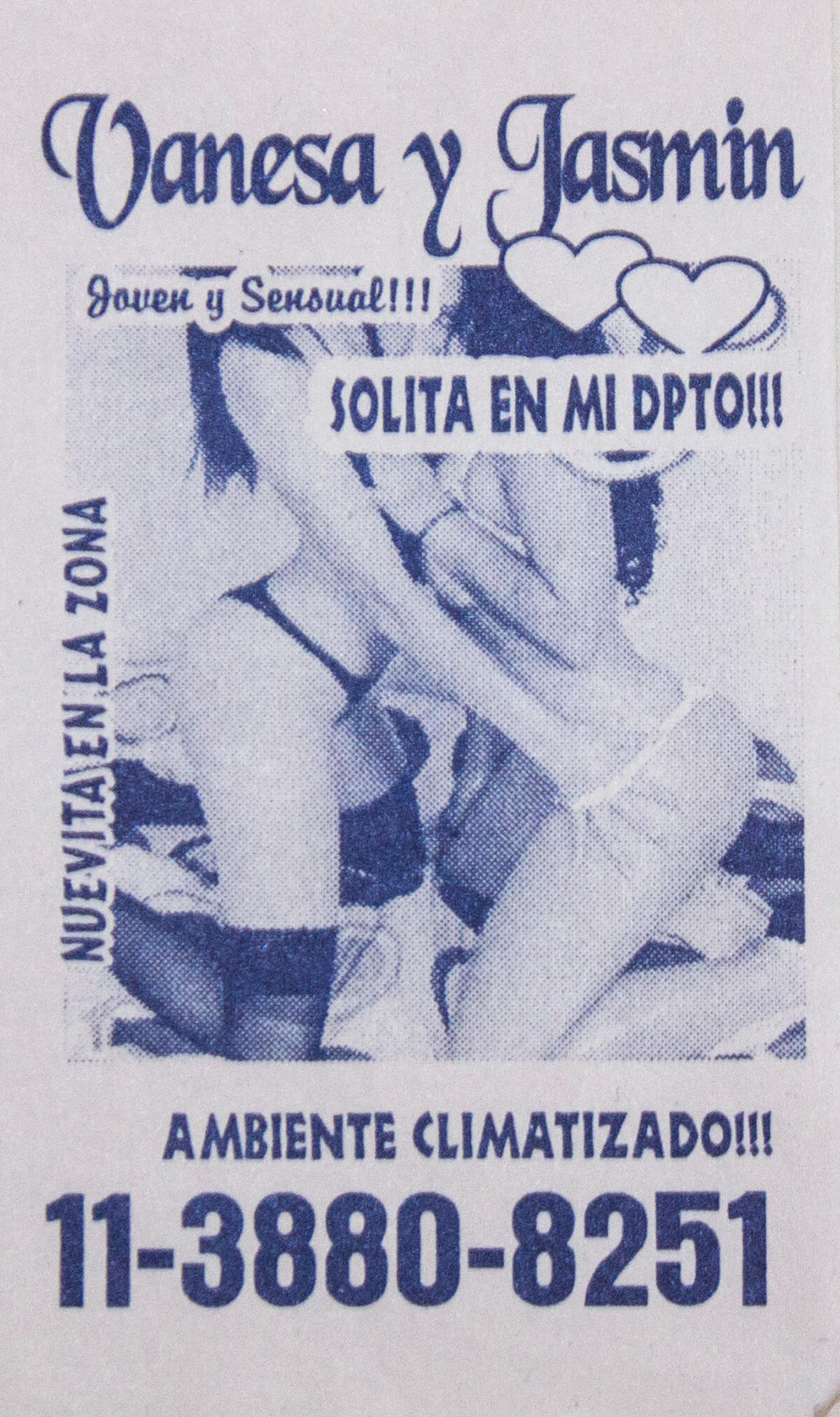
Cards like this aren’t unique to Buenos Aires. In London, where they originated in the sixties, they’re known as tart cards, and are most frequently (and fittingly) found on the interiors of those red telephone booths. Notoriously seedy cities, like Las Vegas and São Paulo, also have them. But all cities are seedy in their own right, so you’ll find versions in everywhere from Dubai to Macau. They’re kind of like the internet dating ads Alain Badiou describes in his In Praise of Love, with slogans like “Get love without chance!,” “Be in love without falling in love!,” “Get perfect love without suffering!,”1 the difference being that culo cards are about phone calls, which have the added intimacy of the voice, or in cities with pay phones, can’t be tracked.
What struck me about the cards wasn’t their flagrant objectification of women; sadly, that’s not very striking. Rather, it was their cuteness. Even the most graphically jarring representations of women—bare-chested with fake tits, eyes obscured with pixels, bent over, waiting to be nailed—are paired with a flourish of hearts. Following cultural theorist Sianne Ngai, these cards encapsulate the twin desires of cuteness: coddling, domination. “There is no judgment or experience of an object as cute that does not call up one’s sense of power over it as something less powerful.”2 The cuter the card, the more powerful the beholder feels.
Discussing images of stereotype and caricature, art historian W.J.T. Mitchell writes that “a typical strategy of caricature is to render the human features in terms of some lower life-form, usually an animal.”3 On the cutest of cards, the human figure is altogether replaced with sweet and familiar cartoon animals. My favorite of these pictures a kawaii-looking panda, with a loving gaze, advertising La Casita del Amor where you’ll find hermosas, a rather chivalrous way to describe a woman who’s just doing her job, often against her will (many of the cards have the safeguarded caveat, trabajo sexual no es lo mismo que trata de personas, meaning “sex work is not the same as human trafficking.”)
Another reads cariñosa, a term of endearment meaning affectionate or loving, above a dozing Bedtime Bear, whose crescent moon bed cradles them in a cloud of hearts instead of the usual stars. Then there was the one with Baby Cheer Bear (cuter than “adult” Cheer Bear, it wears a tiny bow atop its head), who shyly waits for your arrival. A cartoon bunny, gazing longingly toward a suitor, a daisy clasped in its paws.
*
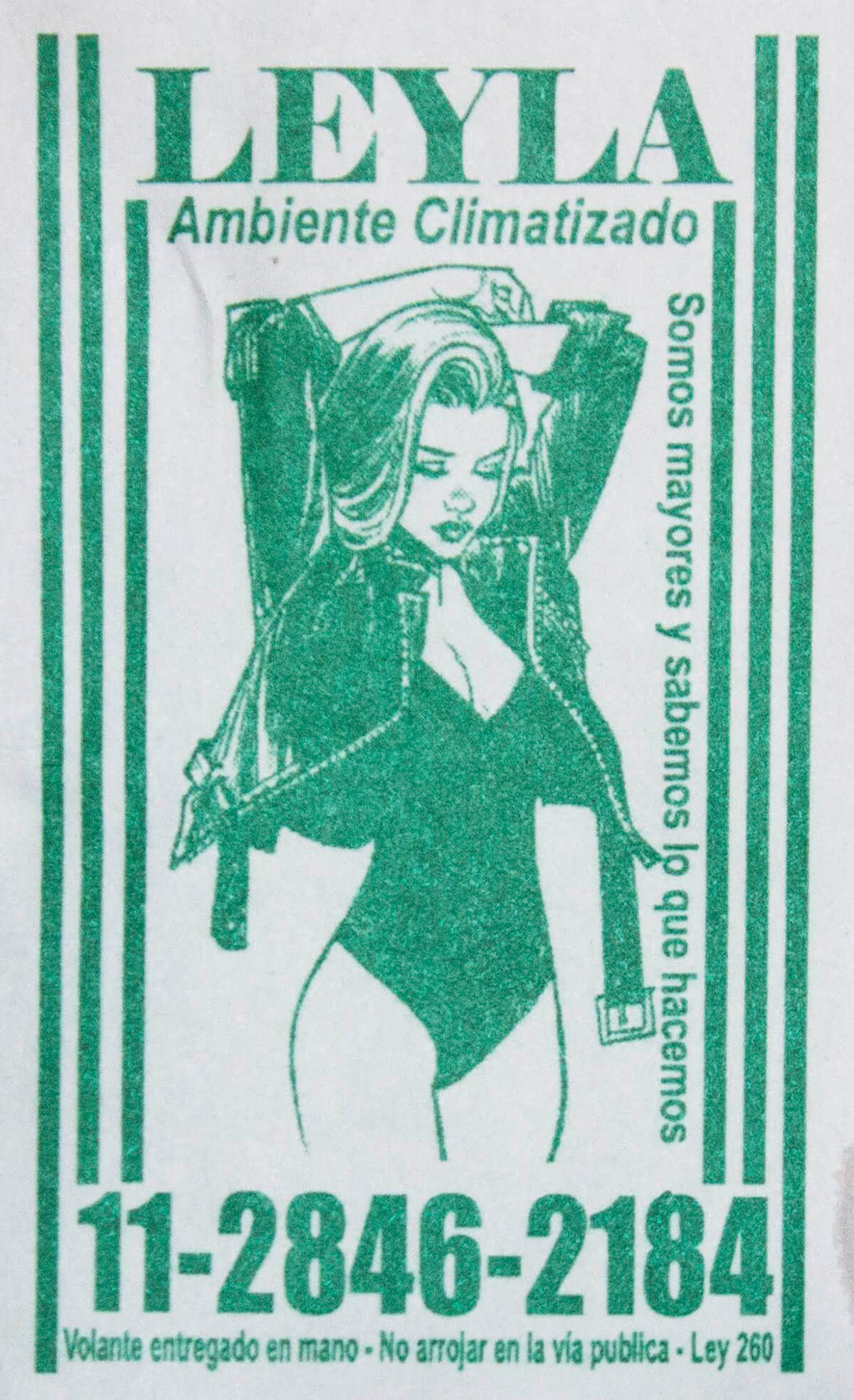
The Jacaranda trees that line Buenos Aires’ broad, cobblestoned streets turn violet in the November spring. Sunsets seem richer and more vibrant, yielding a dusky, glowing blend of pinks, purples, and tangerines. Haussmannesque buildings infused with the Spanish colonial style manifest a mélange of lovey-dovey cliches. It’s a sensual, romantic city, a place of tango and amor.
I didn’t know what to think. I had never been to Buenos Aires—or anywhere beyond Central America—before making the move from New York. I only had a few friends there, and a few words of Spanish. I didn’t have a job. But having just quit one, unsure of what I would do next, I felt like a teenager compelled by the need for exciting yet rough unfamiliarities—not unlike the thrill of new crush.
Before I left, I heard it from countless friends: “The guys there are really hot.” “Latin American men are better lovers.” “When I lived in Buenos Aires, I fell in love with a tango dancer.” (Really, I’m not making this up.) I spent most of my time alone, with myself. It’s not like I didn’t meet people, but I didn’t go to Buenos Aires to meet someone. Yet at every turn, romance smacked me in the face. The culo cards were especially inescapable. Maybe it’s because I was obsessively collecting and scrutinizing the cards, or maybe it’s because a certain aesthetic ethos is so pervasive, but I started noticing romantic fantasies all around me, especially in overtly cute, commoditized forms.
Los peluches are everywhere in Buenos Aires. It’s like Valentine’s Day year-round. Imagine entering any corner store to find stuffed animals above the cash register or shelved among Ramen packets. There are entire shops dedicated to selling these plush teddy bears, frogs, panda bears, and puppies, with their hearts clutched in their paws or proffered from their mouths, the phrases te amo or loco de amor embroidered on them.
There is something histrionic about these figures, which is fitting. Porteños have a performative streak—their rich history of theater attests to this—and their notoriously wide streets, brim with intentioned action. The Porteño affinity to act in the street is related to Parisian flâneurism; however, it is much more politicized in its integration of the plaza, drawn from Buenos Aires’ provincial past. Militaristic defensive strongholds, performative squares for bullfighting and dancing, spaces for meeting and being seen, power dynamics of all kinds have played out in this specifically public space.
Buying a peluche could be the performance of romance, albeit a politicized one. It is the act of giving as instantiation of one’s devotion, and a peace offering. It reminds me of literary theorist and feminist scholar Lori Merish’s theories on the aesthetics and commodification of cuteness, which involves a “a structure of identification, wanting to be like the cute—or more exactly, wanting the cute to be just like the self.”4 Cute objects compel the buyer to act cute, to appear innocent.
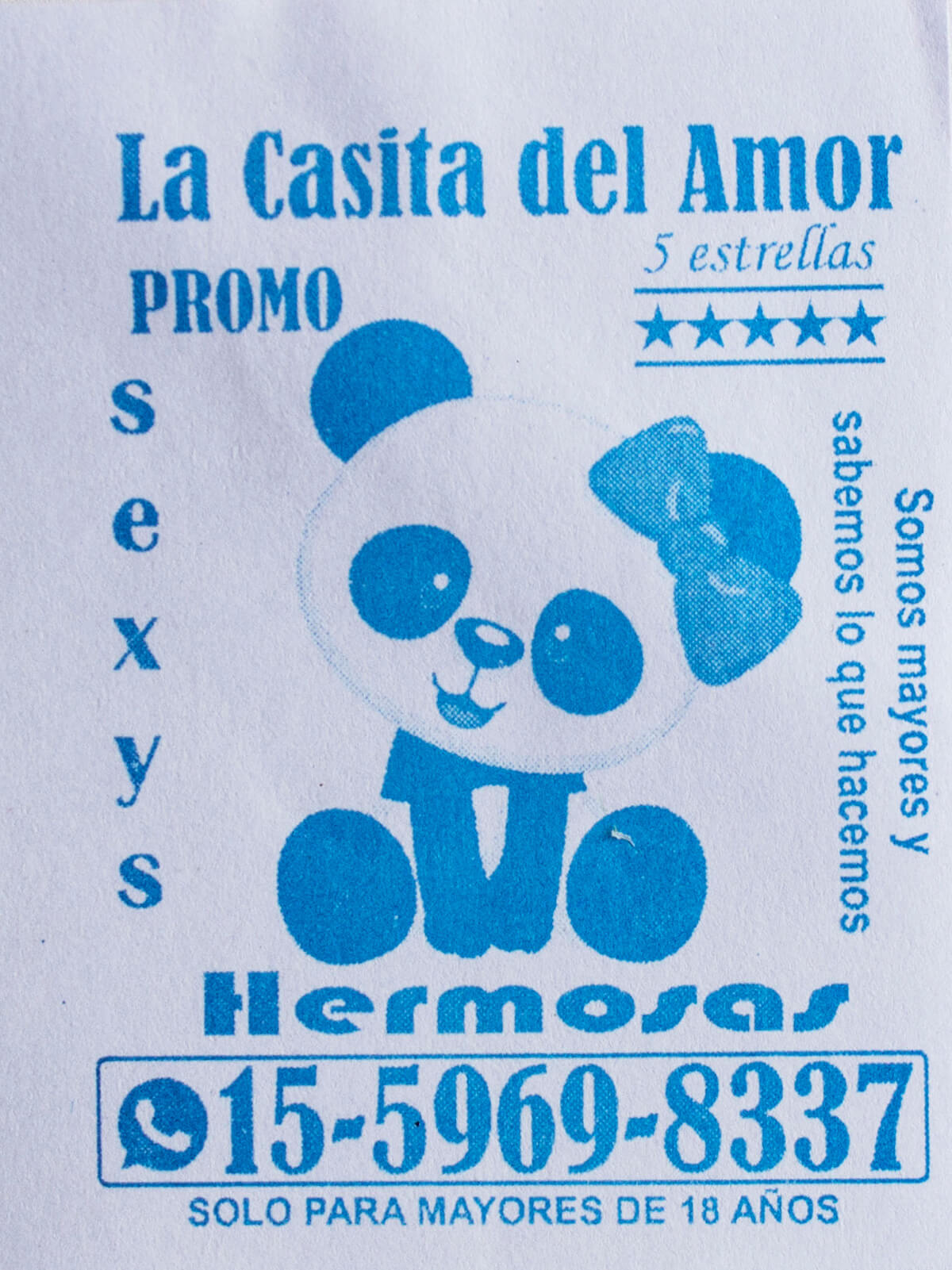
This structure of identification is found in death, too. I spent innumerable hours in the Cementerio de la Chacarita, which was next to my apartment. It’s a necropolis unto itself, the design of which echoes that of the city. Mausoleums, in rows on wide, tree-lined avenues, are like mini-apartments, with glass façades that display altars of adoration, more reminiscent of living room mantels than tombs. Here again is performativity, not to mention class politics. Eternity is expensive, evidenced by the mausoleums in disrepair, used by graveyard attendants like janitorial closets, or tombs where bones are actually visible.
Around Chacarita’s perimeter, and especially at its grandiose, pink neoclassical entrance, venders sell fake flowers, plastic urns, and heart-shaped placards with lovable images, paired with sentimental phrases—like Hallmark cards for the afterlife. Mourners purchase these trinkets to leave on the tombs. The effects are typically personalized with handwritten notes, photos of the departed, or objects that must have meant something to the deceased—a bottle of wine, a football jersey, toys and stickers for children. If, following Ngai, the cute is paradoxically tender while inciting aggression, it is also paradoxical in its use-value. Cute commodities are not merely cute to spur consumption; they make things real:
Since consumption is the activity in which one realizes a commodity’s use-value, for Marx it technically belongs outside economics proper, “except in so far as it reacts in turn upon the point of departure and initiates the whole process anew.” Cuteness, an adoration of the commodity in which I want to be as intimate with or physically close to as possible, thus has a certain utopian edge, speaking to a desire to inhabit a concrete, qualitative world of use as opposed to one of abstract exchange. 5
Reaching beyond transactional exchange, all of the commodities under consideration do this in some way, and loosely align with Kierkegaard’s three levels of love: the aesthetic culo cards fulfil biological desire, the ethical peluches mend or strengthen a relationship, and the divine or super-human graveyard mementos bring a loved one back to life.6
*
These images, objects, and rituals fundamentally represent Mitchell’s theories about the picture-beholder relationship, which he describes as “a field of mutual desire.”7 To illustrate this, he references an iconic scene from David Cronenberg’s Videodrome. In one of his many hallucinations, Max Wren, who is developing a new form of television, is seduced by the televised image of his new fling, Nicki Brand. Her lips bulge beyond the screen, calling to him, “Come to me. Come to Nicki. Don’t make me wait.” Realizing that Cronenberg’s language is just like that of the culo cards (Nicki, a “cute” name, is even one I found on the cards), I looked up the trailer for the movie. One of its lines goes like this: “Soon, his visions will coalesce, and become uncontrollable flesh. Videodrome is seducing Max Wren.”
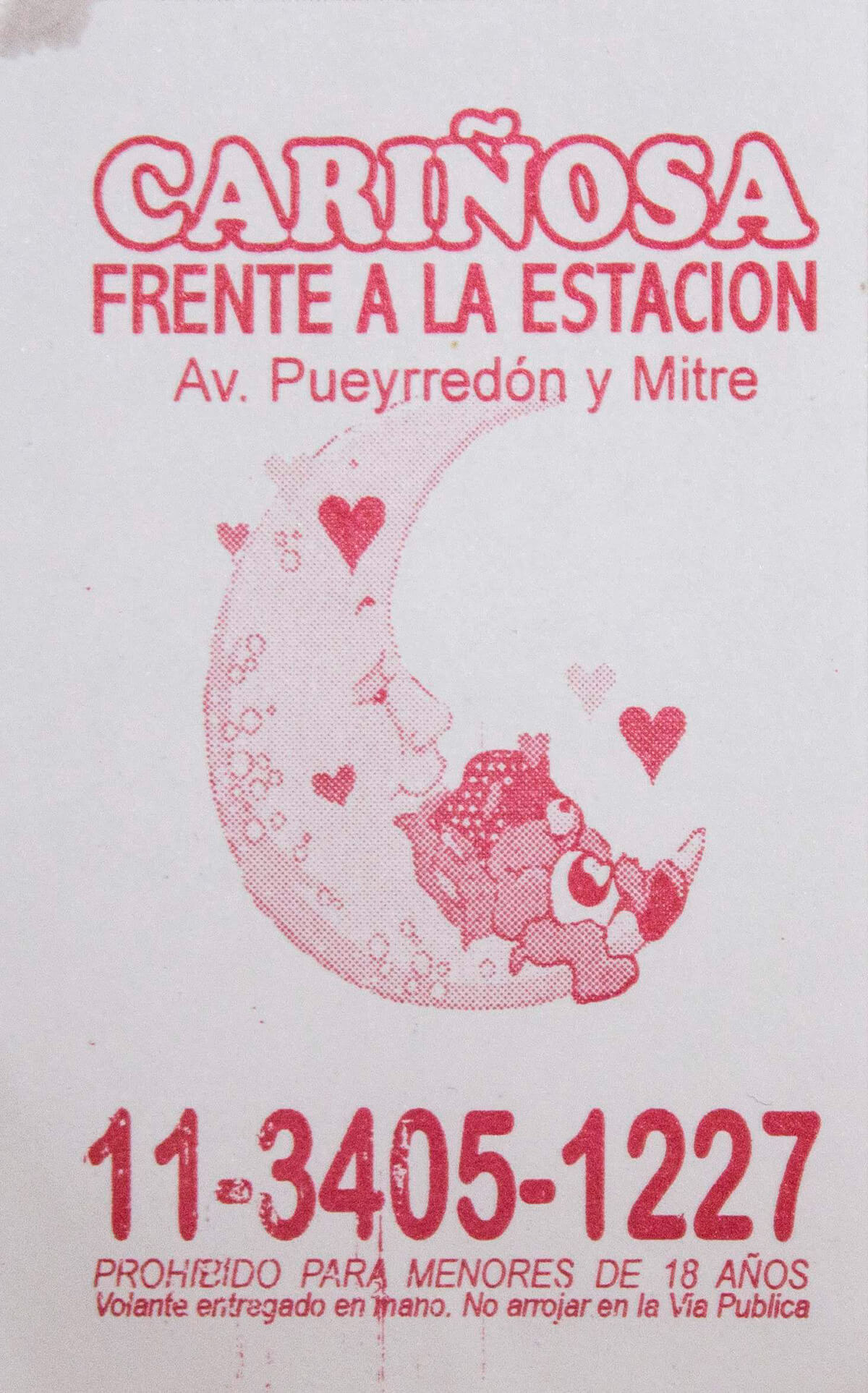
Buenos Aires is a seductive place. It’s easy to think of an outsider’s clichéd expectations of the city: a vacation of red meat, velvety Malbec and cheap leather goods, tango danced in the subtropical breeze. With precarious labor becoming the norm worldwide, there’s a growing trend of young freelancers, who can work from anywhere with a Wi-Fi signal, relocating to cities like this. It’s a form of global gentrification, perhaps even more egregiously privileged than what happens back at home, partly because it isn’t just about having money.
Sarah Schulman’s writing on gentrification in New York during the AIDS crisis is useful here: “...what I mean in the case of the gentrifiers is that they were ‘privileged’ in that they did not have to be aware of their power or of the ways in which it was constructed. [...] Gentrification is a process that hides the apparatus of domination from the dominant themselves.”8 There’s no real need to know the historical reasons why you can live so cheaply in a place. It’s not a mutual relationship. There’s no real political or economic risk.
And here is Badiou: “Clearly, inasmuch as love is a pleasure almost everyone is looking for, the thing that gives meaning and intensity to almost everyone’s life, I am convinced that love cannot be a gift given on the basis of a complete lack of risk.”9
*
Culo cards weren’t always cute. In 1967, artist Roberto Jacoby made Circuito Automático (Automatic Circuit). He printed small posters in the style of dating ads to post around Buenos Aires. Each pictured a younger man on one side and woman on the other, with a phone number in between them. That was it. Just information, and the potential excitement of calling the number.
I bring this up because I’ve been leaning heavily on Ngai and Merish’s theories of cuteness and commodity forms. Both are very specific to Western contexts and pull from primarily Western sources. Thus, these texts can only help so much. Jacoby’s straightforward design therefore bequeaths another culturally-specific framework. He based his cards on those that were in circulation at the time of the work’s creation. Therefore, in the decades that have passed since his original piece, the culo cards have undergone a significant aesthetic transformation. It calls to mind other theories of cuteness, which argue that its growing predominance in cultures around the globe may be indicative of neoliberal precarity and all of the social changes this engenders respective to specific geographic contexts.
Cuteness, at least momentarily, alleviates some of the depression, anxiety, and existential despondency people (employed or not) grapple with everywhere.10 These aesthetic objects may be so commonplace in Buenos Aires because of the dire living conditions of many Argentinians, felt since the economic fallout out of dictatorships, with any progress made following this dark period set back in 2001, and again not even a year ago after Macri’s IMF bailout. It’s no wonder my cab drivers dishearteningly quipped about switching places with me, the privileged white American who can get paid in U.S. dollars.
Even if cuteness is growing in popularity—TY Inc. is having a comeback with Beanie Boos, Lisa Frank did a collab with Louis Vuitton, there’s a Rilakuma pop-up shop in Times Square—there’s something about cute that still isn’t cool. To be cool is to be disinterested: “I woke up like this” and #nofilter selfies; the minimalist, sterile, and “frictionless” aesthetic of contemporary gentrification; the sleek design of Juul paired with the company’s cool, distanced marketing (so effective, their Instagram account is no longer active, which makes them even cooler).
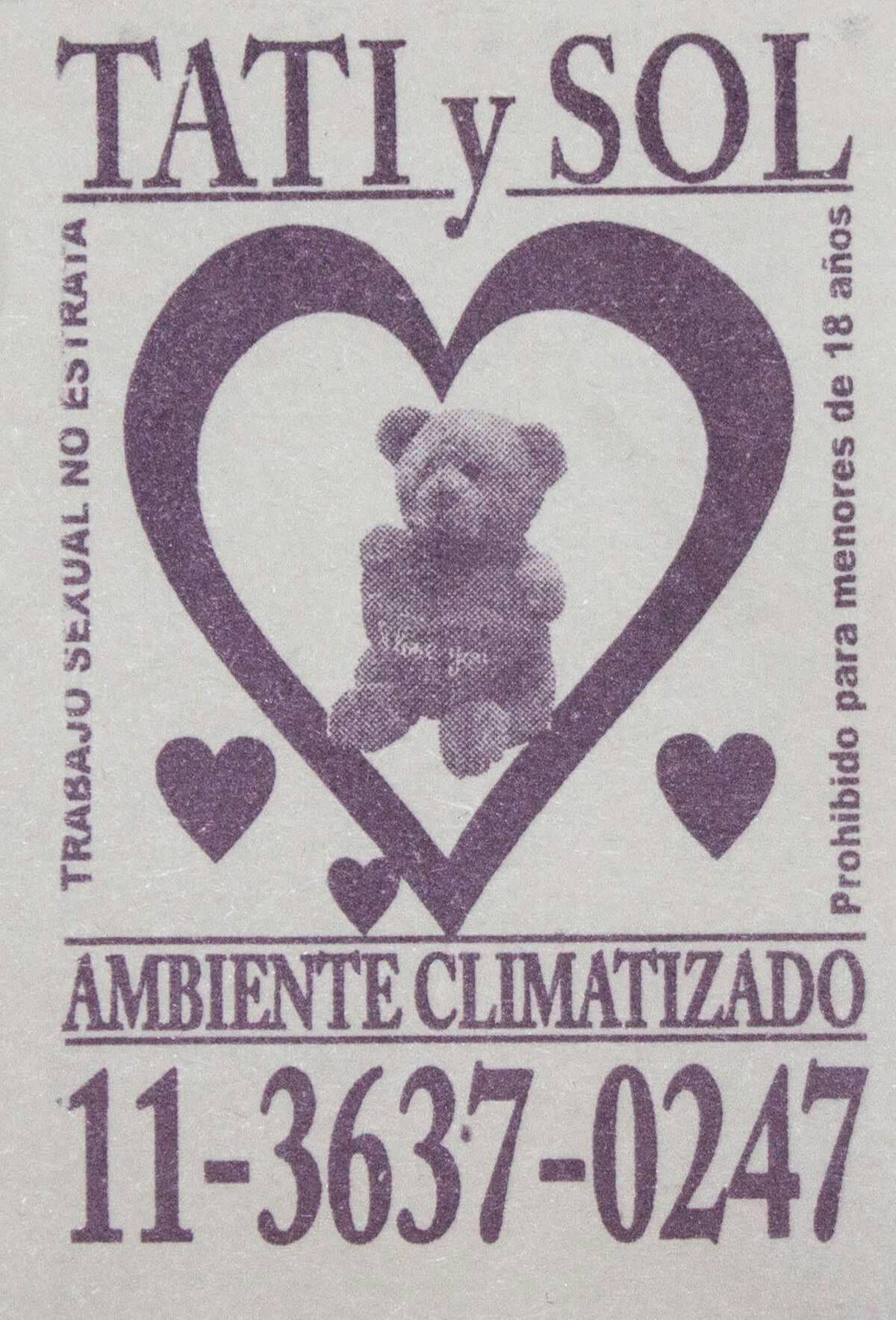
But to be disinterested is to be privileged, the kind of privilege that is best exemplified by the Theranos fraud, and made all the more visible with the recent Fyre Festival scandal: A white dude convincing other white dudes that his “crazy” idea could generate everyone millions. He looked the part (white male), talked the talk (money), and got what he wanted despite having no credentials (literally), an exaggerated version of what goes down with many new startups. The flipside of this privilege is felt in Buenos Aires, with restricted capital, devalued currency, lost opportunity.
Cute is diametric to disinterestedness. Cute cares. Its aesthetic is kitschy, corny, schmaltzy. And it’s this last characteristic, especially, that makes it seem genuine and heartfelt. Take, for instance, Celine Dion’s unparalleled international fame. Schmaltziness is what music critic Carl Wilson, in Let’s Talk About Love, identifies as the undercurrent of Dion’s music that enables an identification between her and her fans; her sentimentality is taken as earnest. Referencing Charles Hamm’s 1979 study of American parlor songs, Yesterdays, Wilson writes that schmaltz “is never purely escapist: it is not just cathartic but socially reinforcing.”11 Wilson goes on to define schmaltz as: “an unprivate portrait of how private feeling is currently conceived.”12 Which is precisely what we see in the culo cards, peluches, and graveyard mementos, and the displays that are enacted through them. For better or worse, they reinforce social bonds. They are the private made public in meaningful ways. And their effects are undeniably real.
*
It hit me at dusk a few days before leaving, collecting culo cards on Corrientes, strolling from San Telmo into Monserrat. I was trying to absorb everything around me, not knowing when I would return. After traversing the touristy blocks, I found myself in front of the Casa Rosada, standing in the Playo de Mayo, where mothers of the disappeared gathered to protest the most ruthless of dictatorial periods in Buenos Aires’s history.
It was also where, a month before, I had danced with dozens of new friends, singing along to Dani Umpi in the XXVI Marcha Del Orgullo LGBTIQ. (“What is the world like when it is experienced, developed and lived from the point of view of difference and not identity?”13) Now I stood there, under blossoming Jacaranda trees, surrounded by people with their loved ones, alone. The sun was about to set on an unusually overcast day when I started to cry. I had fallen in love.
-
Alain Badiou and Nicolas Truong, In Praise of Love, trans. Peter Bush (London: Serpent’s Tail, 2012), 6.
-
Sianne Ngai, Our Aesthetic Categories: Zany, Cute, Interesting (Cambridge, MA: Harvard University Press, 2015), 11.
-
W.J.T. Mitchell, What Do Pictures Want? The Lives and Loves of Images (Chicago: The University of Chicago Press, 2005), 20.
-
Lori Merish, “Cuteness and Commodity Aesthetics: Shirley Temple and Tom Thumb,” in Freakery: Cultural Spectacle of the Extraordinary Body, ed. Rosemarie Thomson (New York: New York University Press, 1996), 185–203.
-
Ngai, Our Aesthetic Categories (Cambridge, MA: Harvard University Press, 2012), 12-13.
-
Robert L. Perkins, ed., Works of Love (Macon, GA: Mercer University Press, 1999).
-
W.J.T. Mitchell, What Do Pictures Want?, XV.
-
Sarah Schulman, The Gentrification of the Mind: Witness To A Lost Imagination (Berkeley, CA: California University Press, 2013), 26-27.
-
Badiou and Truong, In Praise of Love, 7.
-
See The Aesthetics and Affects of Cuteness, ed. Joshua Paul Dale, Joyce Goggin, Julia Leyda, Anthony P McIntyre, and Diane Negra (New York: Routledge, 2017).
-
Carl Wilson, Let’s Talk About Love: A Journey to the End of Taste (New York; London: Bloomsbury, 2007), 61.
-
Ibid.
-
Badiou and Truong, In Praise of Love, 22.